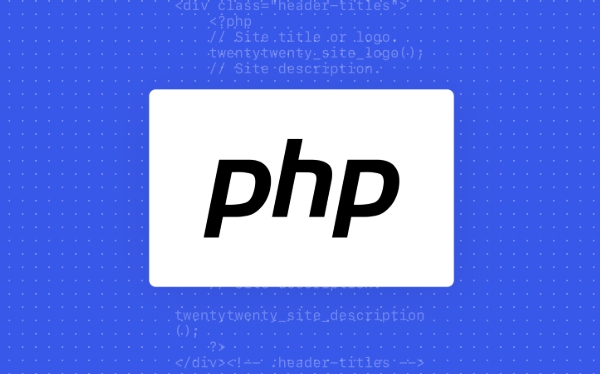 Backend Development
Backend Development
 PHP Tutorial
PHP Tutorial
 The Lingering Reference: A Critical Pitfall in PHP foreach Loops
The Lingering Reference: A Critical Pitfall in PHP foreach Loops
The Lingering Reference: A Critical Pitfall in PHP foreach Loops
Unset variables after using the foreach loop using reference syntax will cause the subsequent loop to accidentally modify the array; 2. Because the &$value still points to the last element of the original array after the loop ends, subsequent assignments will directly modify the value at that location; 3. The solution is to call unset($value) immediately after the reference loop to disconnect the reference; 4. Best practices include avoiding variable name reuse, using references only when the original array needs to be modified, and using clear naming of the reference variables; 5. This behavior is a normal manifestation of the PHP reference mechanism, which is not a bug, but must be prevented by correctly cleaning up the references, so unset($value) must be unset($value) after using &$value to ensure safety.

When working with PHP's foreach loop, developers often assume it's a straightforward construct—until subtle bugs appear. One of the most notorious and frequently misunderstood issues is the lingering reference . This pitfall can lead to unexpected behavior, especially when reusing variables or looping over arrays multiple times.

What Is the Lingering Reference?
In PHP, foreach operates on a copy of the array by default, but if you use the reference syntax ( &$value ), it creates a reference to the actual array element. The problem arises when that reference isn't properly cleaned up after the loop ends.
Consider this example:

$arr = [1, 2, 3];
foreach ($arr as &$value) {
$value *= 2;
}
print_r($arr); // Output: [2, 4, 6] — expected
foreach ($arr as $value) {
// do nothing
}
print_r($arr); // Output: [2, 4, 4] — wait, what?The final element changed from 6 to 4? That's the lingering reference in action.
Why Does This Happen?
Let's break it down:

- In the first loop,
&$valuecreates a reference to the last element of$arr(ie, the value6). - After the loop,
$valuestill points to that last array element—it doesn't get destroyed or unset automatically. - In the second
foreach, when PHP assigns each array element to$value, it's not working with a local variable—it's writing into the referenced location. - So during the second loop:
- First iteration:
$value = 2→ writes 2 into the last element of$arr - Second iteration:
$value = 4→ writes 4 into the last element - Third iteration:
$value = 4(again) → writes 4 again
- First iteration:
Hence, the last element becomes 4 instead of staying 6.
How to Avoid the Pitfall
The fix is simple but often overlooked: unset the reference after the loop .
$arr = [1, 2, 3];
foreach ($arr as &$value) {
$value *= 2;
}
unset($value); // Break the reference
foreach ($arr as $value) {
// Now safe to use $value without side effects
}
print_r($arr); // Output: [2, 4, 6] — correct By calling unset($value) , you sever the reference, ensuring that any future use of $value won't accidentally modify the original array.
Best Practices
To avoid this issue entirely, follow these guidelines:
- Always unset referenced loop variables when using
&$valueinforeach. - Avoid reusing variable names across loops if one uses references.
- Prefer value iteration unless you specifically need to modify the original array.
- Use distinct variable names for references to make their purpose clear.
For example:
foreach ($items as &$item) {
$item['processed'] = true;
}
unset($item); // Crucial stepFinal Note
This behavior is documented in PHP's manual but often surprises developers because it's not intuitive. The same variable name can "leak" state between loops in ways that break logic silently.
The lingering reference isn't a bug—it's a consequence of how references work in PHP. But without awareness, it becomes a critical pitfall.
Basically: if you use &$value in foreach , always unset($value) right after. It's a small step that prevents big headaches.
The above is the detailed content of The Lingering Reference: A Critical Pitfall in PHP foreach Loops. For more information, please follow other related articles on the PHP Chinese website!

Hot AI Tools

Undress AI Tool
Undress images for free

Undresser.AI Undress
AI-powered app for creating realistic nude photos

AI Clothes Remover
Online AI tool for removing clothes from photos.

Clothoff.io
AI clothes remover

Video Face Swap
Swap faces in any video effortlessly with our completely free AI face swap tool!

Hot Article

Hot Tools

Notepad++7.3.1
Easy-to-use and free code editor

SublimeText3 Chinese version
Chinese version, very easy to use

Zend Studio 13.0.1
Powerful PHP integrated development environment

Dreamweaver CS6
Visual web development tools

SublimeText3 Mac version
God-level code editing software (SublimeText3)
 PHP Variable Scope Explained
Jul 17, 2025 am 04:16 AM
PHP Variable Scope Explained
Jul 17, 2025 am 04:16 AM
Common problems and solutions for PHP variable scope include: 1. The global variable cannot be accessed within the function, and it needs to be passed in using the global keyword or parameter; 2. The static variable is declared with static, and it is only initialized once and the value is maintained between multiple calls; 3. Hyperglobal variables such as $_GET and $_POST can be used directly in any scope, but you need to pay attention to safe filtering; 4. Anonymous functions need to introduce parent scope variables through the use keyword, and when modifying external variables, you need to pass a reference. Mastering these rules can help avoid errors and improve code stability.
 Tips for Writing PHP Comments
Jul 18, 2025 am 04:51 AM
Tips for Writing PHP Comments
Jul 18, 2025 am 04:51 AM
The key to writing PHP comments is to clarify the purpose and specifications. Comments should explain "why" rather than "what was done", avoiding redundancy or too simplicity. 1. Use a unified format, such as docblock (/*/) for class and method descriptions to improve readability and tool compatibility; 2. Emphasize the reasons behind the logic, such as why JS jumps need to be output manually; 3. Add an overview description before complex code, describe the process in steps, and help understand the overall idea; 4. Use TODO and FIXME rationally to mark to-do items and problems to facilitate subsequent tracking and collaboration. Good annotations can reduce communication costs and improve code maintenance efficiency.
 Commenting Out Code in PHP
Jul 18, 2025 am 04:57 AM
Commenting Out Code in PHP
Jul 18, 2025 am 04:57 AM
There are three common methods for PHP comment code: 1. Use // or # to block one line of code, and it is recommended to use //; 2. Use /.../ to wrap code blocks with multiple lines, which cannot be nested but can be crossed; 3. Combination skills comments such as using /if(){}/ to control logic blocks, or to improve efficiency with editor shortcut keys, you should pay attention to closing symbols and avoid nesting when using them.
 Learning PHP: A Beginner's Guide
Jul 18, 2025 am 04:54 AM
Learning PHP: A Beginner's Guide
Jul 18, 2025 am 04:54 AM
TolearnPHPeffectively,startbysettingupalocalserverenvironmentusingtoolslikeXAMPPandacodeeditorlikeVSCode.1)InstallXAMPPforApache,MySQL,andPHP.2)Useacodeeditorforsyntaxsupport.3)TestyoursetupwithasimplePHPfile.Next,learnPHPbasicsincludingvariables,ech
 Quick PHP Installation Tutorial
Jul 18, 2025 am 04:52 AM
Quick PHP Installation Tutorial
Jul 18, 2025 am 04:52 AM
ToinstallPHPquickly,useXAMPPonWindowsorHomebrewonmacOS.1.OnWindows,downloadandinstallXAMPP,selectcomponents,startApache,andplacefilesinhtdocs.2.Alternatively,manuallyinstallPHPfromphp.netandsetupaserverlikeApache.3.OnmacOS,installHomebrew,thenrun'bre
 How to use PHP to build social sharing functions PHP sharing interface integration practice
Jul 25, 2025 pm 08:51 PM
How to use PHP to build social sharing functions PHP sharing interface integration practice
Jul 25, 2025 pm 08:51 PM
The core method of building social sharing functions in PHP is to dynamically generate sharing links that meet the requirements of each platform. 1. First get the current page or specified URL and article information; 2. Use urlencode to encode the parameters; 3. Splice and generate sharing links according to the protocols of each platform; 4. Display links on the front end for users to click and share; 5. Dynamically generate OG tags on the page to optimize sharing content display; 6. Be sure to escape user input to prevent XSS attacks. This method does not require complex authentication, has low maintenance costs, and is suitable for most content sharing needs.
 PHP calls AI intelligent voice assistant PHP voice interaction system construction
Jul 25, 2025 pm 08:45 PM
PHP calls AI intelligent voice assistant PHP voice interaction system construction
Jul 25, 2025 pm 08:45 PM
User voice input is captured and sent to the PHP backend through the MediaRecorder API of the front-end JavaScript; 2. PHP saves the audio as a temporary file and calls STTAPI (such as Google or Baidu voice recognition) to convert it into text; 3. PHP sends the text to an AI service (such as OpenAIGPT) to obtain intelligent reply; 4. PHP then calls TTSAPI (such as Baidu or Google voice synthesis) to convert the reply to a voice file; 5. PHP streams the voice file back to the front-end to play, completing interaction. The entire process is dominated by PHP to ensure seamless connection between all links.
 How to use PHP combined with AI to achieve text error correction PHP syntax detection and optimization
Jul 25, 2025 pm 08:57 PM
How to use PHP combined with AI to achieve text error correction PHP syntax detection and optimization
Jul 25, 2025 pm 08:57 PM
To realize text error correction and syntax optimization with AI, you need to follow the following steps: 1. Select a suitable AI model or API, such as Baidu, Tencent API or open source NLP library; 2. Call the API through PHP's curl or Guzzle and process the return results; 3. Display error correction information in the application and allow users to choose whether to adopt it; 4. Use php-l and PHP_CodeSniffer for syntax detection and code optimization; 5. Continuously collect feedback and update the model or rules to improve the effect. When choosing AIAPI, focus on evaluating accuracy, response speed, price and support for PHP. Code optimization should follow PSR specifications, use cache reasonably, avoid circular queries, review code regularly, and use X






